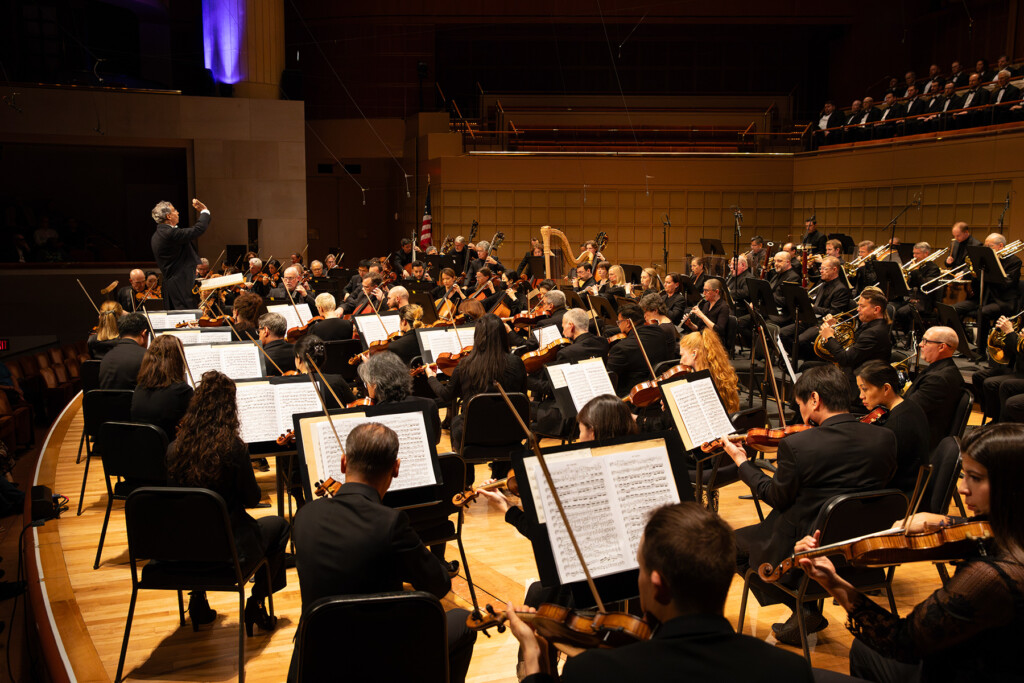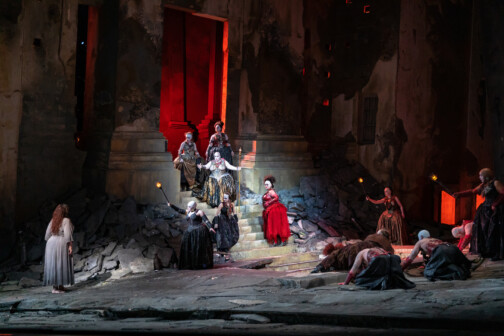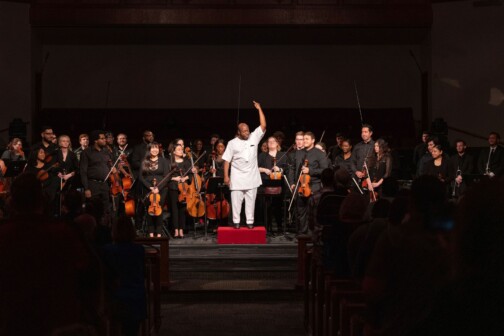For 80 years, some of the world’s most celebrated classical composers have written new symphonies and more for the Dallas Symphony to perform. Curious to learn more about what past masterpieces might have local roots, I dove into the history of classical music in Dallas—specifically, classical music written for Dallas in our November issue of D Magazine. You can read about our century-long legacy of new music here, which is online today.
But I didn’t just want to write about the DSO’s musical legacy. I wanted to listen to it. To help you do the same, we’ve created a playlist—nearly 15 hours long—showcasing all the music written for the Dallas Symphony that has been recorded and uploaded to streaming services. The Spotify version is embedded right here:
The DSO playlist is also available on Qobuz.
Below, you’ll find my own guide to the music presented. Want to skip to the really good (or bad) stuff? Need a recommendation or some historical context? Keep scrolling. At the bottom, I’ve also got a few YouTube links.
My notes are not in playlist order. I’ve grouped them into sections. You should be able to find what you want by searching in the page for a composer or title.
The Dallas Classics
The Morton H. Meyerson Symphony Center was inaugurated with a two-minute miniature by Luciano Berio, Festum, that has the modest goal of being fizzy, fun, full of solos, and over quickly. Maybe we should begin another season with it.
William Schuman’s Symphony No. 6, premiered in 1949, is an emotionally bleak, mournful half-hour. The composer himself later wrote of its Dallas audience, “some were so incensed with the work that they questioned whether they should even complete payment of the commission.” It does have a dead spot in the middle where an audience’s attention could wander, but there are moments of real fragile beauty in this piece, like the hushed opening, as well as powerfully physical climaxes. The gloomy arc format paves the way for future DSO commissions by the likes of Christopher Rouse and James MacMillan.
The other really excellent DSO commission from the era right after World War II, Bohuslav Martinů’s Concerto for Two Violins and Orchestra, strikes the exact opposite emotional tone from Schuman. Instead of Mennin’s pent-up rage, Martinů offers sunny optimism and glorious tunes, in a concerto that has echoes of Haydn, Mozart, and the baroque era. His Piano Concerto No. 3 is more stern and somber, but a brand-new album by pianist Olli Mustonen reveals that it has a spiritual, mystical side, too, and makes the music sound wonderfully impressionist. That’s the recording I’ve placed on our playlist. (The double violin concerto’s best recording is not available on streaming. This one is slower and stodgier, but we gotta take what we can get.)
Peter Mennin’s short Fifth Symphony comprises two furiously driven toccatas, with blaring brass and pounding drums, with a soft, slow, romantic “canto” in between to give your ears a break. I liked it at first listen, though it sounded more superficial when I revisited it later. Julián Orbón’s Partita No. 4 dates from Eduardo Mata’s time with the DSO; Orbón was one of his teachers. If you’re looking for Hispanic flavor, you’ll be disappointed: it alternates calm and angsty episodes with jarring quickness, and with a showy solo piano part. The intellectual hook is a hidden quotation of Renaissance composer Tomás Luis Victoria. It’s tough but rewarding.
On the other side of the spectrum—the easy and fun and riotous side—is Jennifer Higdon’s Percussion Concerto. Percussion instruments can’t exactly express a lot of emotion (imagine a drum being sad), but they can make lots of loud things go bang, and that’s Higdon’s goal here. If you just want to hear an exciting racket, this is great stuff.
If you’ve heard of Miklós Rózsa, it’s because he won a series of Oscars writing tunes for classic Hollywood movies like Ben-Hur, Double Indemnity, Spellbound, or (for the Steve Martin superfan) Dead Men Don’t Wear Plaid. His Violin Concerto is a rustic, nostalgic, thoroughly enjoyable tribute to his native Hungary and its folk music.
To my ears, some of our best recent premieres are by Christopher Rouse. His Symphony No. 5 is a flat-out masterpiece: dramatic, white-knuckle tense, showy, and perhaps the all-time record holder for most big bass drum thwacks. (Its beginning is a twisted, evil version of the famous beginning of Beethoven’s Fifth.) His Concert de Gaudí is more relaxed fun, a guitar concerto that evokes flavors of Barcelona and its native architect.
Dallas Natives, Composers-in-Residence, and Local Connections
Samuel Adler’s first two symphonies follow Mennin’s format—short and fast intro and conclusion, long and slow middle bit—but with less rage and more gleaming American optimism instead. His music is a charming mixture of Hindemith’s dense ideas and Copland’s big tunes. My experience with them was the opposite as with the Mennin symphony: I thought they were a little dull at first, but then started liking them much more after a second listen. The recordings available online are underrehearsed and weak, so you have to imagine they would sound much better on the Dallas stage today.
One of the biggest commissions in the DSO’s history is Lowell Liebermann’s Symphony No. 2, which the orchestra recorded for CD with the Dallas Symphony Chorus singing poems by Walt Whitman in every section. There’s a radiant glow to the piece, which combines epic Hollywood sweep, romantic warmth, and a spirit of gratitude and love of life appropriate to the poet. The symphony faced criticism at the time for being derivative, which is a fair complaint. Liebermann borrows from past composers and his march sounds like a deleted scene from Star Wars. But, though far from original, the symphony is also heartfelt and wholly entertaining. If you don’t love classical music, this will be one of your favorite pieces on the list. Liebermann’s Concerto for Harp, Flute, and Orchestra is a similar deal, with serene slower moments and fun solos, though you do have to like the rather sweet sounds of harp and flute together.
Two of Robert Xavier Rodríguez’ works for the DSO have been recorded: Oktoechoes and Favola Boccaccesca. Favola is the more immediately likable of the two, with loads of color and lively faux-medieval episodes, while Oktoechoes sets two groups of solo instruments against the orchestra in an intricate many-sided conversation.
The DSO can seem as haunted by political history as the rest of our city. This year, it is one of the co-commissioning organizations for Adolphus Hailstork’s JFK: The Last Speech, and one of the orchestra’s largest-ever commissions obliquely addresses fallout from the assassination. August 4, 1964, an hour-long work by Steven Stucky, combines the Gulf of Tonkin incident and the murder of two civil rights workers into a piece with singing parts for Lyndon B. Johnson, Robert McNamara, and the civil rights workers’ mothers. Stucky wrote in the booklet that his portrayal of Johnson was influenced by his childhood in Abilene and his memories of Kennedy’s death.
August 4, 1964 is a strange hybrid of different genres, and it’s especially difficult to listen to on a streaming platform. The characters’ perspectives mix together in a way that could be confusing if you’re not closely following the text. (McNamara enters by interrupting the women as they lament their sons.) The chorus sings presidential diary entries, calendar listings, and agenda items (they even sing “7:05, breakfast”).
As the music bounces back and forth between the different points of view, any chance of opera-like emotional sweep depends on your reaction to Stucky’s film-like music, the emotional commitment of the singers, and the brief glimpses of the characters. McNamara is unnecessary—he mostly yells out news from Vietnam. Johnson is more self-reflective and conflicted, while the two mothers draw emotional responses by starkly stating the facts of their family’s lives.
Spiritual and Solemn Occasions
The Scottish composer James MacMillan, known for music that incorporates his Catholic spirituality, has written two concertos in part for the Dallas Symphony. One, a violin concerto, has yet to be recorded. The other, the Trombone Concerto, manipulates a single tune over a half-hour of variations and is dedicated in memory of a granddaughter who was born with and died of Dandy-Walker syndrome. It is, frankly, a knockout of a piece, maybe my personal favorite on the whole list. (I love the moments when the three orchestral trombones also jump in, forming a bold choir.)
Similarly spiritual, but acoustically very different, is Man of Sorrows, a piano-and-orchestra epic by George Tsontakis with religious section titles like “Crucifixus.” Your mileage will vary: it’s either an intensely thoughtful, reverent piece in the vein of French modernists like Messiaen, or it’s a long slog where nothing happens. I think I’ve just given away my own view. Paul Hindemith’s Symphonia Serena is not as serene as advertised. It boasts an impressively happy ending, but first the music goes in all sorts of peculiar directions, including a long offstage violin solo and a reworking of a miniature by Beethoven. The result is more odd than soothing.
Jonathan Leshnoff’s Violin Concerto No. 2 drew gales of applause when Alexander Kerr premiered it with the DSO in 2018; I was there and was entranced. Listening again now, its appeal and limitations are both evident: the language is film-like, with the violin floating gorgeous melodies over often rather simple one-two-one-two repeated-note accompaniments. But the composer is speaking with heartfelt sincerity, especially in the movement based on Jewish mystical tenets. The music often radiates beauty.
One of the greatest challenges a composer can face is that of writing music about current events. Samuel Adler took the DSO’s toughest commission of all, for Requiescat in Pace. He was asked by phone to write a short work lamenting the death of John F. Kennedy, on the same day Kennedy died, and had the piece ready for a concert performance two weeks later. The hastiness shows, however, in the piece’s shapeless alternation between mourning and rather pitiful mini-outbursts of rage. Joseph Schwantner’s September Canticle, written in reaction to the September 11 terrorist attack, cycles equally superficially through the stages of grief.
The Weird and the Bad
There are, of course, stinkers from all eras. Darius Milhaud, who became famous for witty jazz-influenced ballets, wrote his short Eleventh Symphony for the DSO. It is an unattractive, lurching, loud piece full of bitter harmonies. Schwantner’s Beyond Autumn, with French horn soloist, depicts a poem of his own writing, which has no meaning to me. This music is at its best when playing with spatial effects: the horn player is offstage at the start and end, walking on and off while playing, and the thunderous drums fully exploit the Meyerson’s acoustic. The rest of it is listless and generic.
Cindy McTee’s Timepiece is an eight-minute timewaste. Her Einstein’s Dream takes an interesting idea and proves it uninteresting: she literally depicts Albert Einstein’s career by having the orchestra sound cutesy and old-fashioned (representing old science), then introduces a sharp change (Einstein), then everything is chaotic (because relativity), and electronic sounds start joining the orchestra (because technology). Sigh.
Gunther Schuller’s Symphony 1965 is a good example of the ’60s avant-garde: 20 minutes of random unrelated sounds. Maybe you like that sort of thing; I found it unpleasant. The same description, even more strongly worded, would apply to the Dallas works of Donald Erb. I don’t have further details because I turned the music off.
When the Dallas Symphony professionalized after World War II, its first-ever premiere seems to have been George Antheil’s Over the Plains, a very short piece inspired by Texas landscapes. Now, unfortunately, the tribute sounds sarcastic and glib. We also premiered his Violin Concerto, which is so long and large that it’s never been recorded by an orchestra. The version on our playlist is reduced to just violin and piano. Aaron Jay Kernis’ Violin Concerto is a tough nut to crack; the goofy inclusion of a wooden toy train whistle near the end is like a politician telling a joke to seem likable. (I say this as a Kernis fan.)
Two pieces on the list are just kind of forgettable to me: a tiny miniature by Virgil Thomson and John Corigliano’s Red Violin Concerto. Expanded from a movie soundtrack, the concerto is pleasant, but long and not especially memorable.
Morton Gould’s Symphony No. 3 is memorable because it’s strange. The composer, who was famous at the time for pops albums with names like Jungle Drums, tries to suppress his popular instincts for the first half, instead doling out self-consciously serious, modern music. Then the third movement suddenly takes a jazzy turn, including slapped bass, before the finale pits these styles against each other in a loud mess. Apparently, reviews at the time suggested that the third movement was so good it rendered the rest unneeded, and I’m inclined to agree.
The DSO recently joined a national consortium involved in a project by Mason Bates called Philharmonia Fantastique. The idea is the orchestra plays music to accompany an animated film for kids explaining all the instruments. On streaming, we can’t see the movie while the music plays.
The strangest-ever DSO premiere must be Anatomy of Peace, written by Marvin Hamlisch and orchestrated by Richard Danielpour. This is a musical depiction of a political book by Hungarian writer Emery Reves, arguing that a single global government would prevent the nationalistic terrors of the two World Wars. Reves’ book, published in 1945, advocated for a more powerful United Nations and was enthusiastically endorsed by figures like Albert Einstein. Hamlisch—one of two people to win an Emmy, Grammy, Oscar, Tony, and Pulitzer—was best known for the music to A Chorus Line and frequent collaborations with Barbra Streisand.
But his plan to depict Reves’ ideas in music included a children’s chorus singing a summary of the book (“Nation pride will cease / The world will live in peace”) and a very literal depiction of world affairs. At first, all the instruments are rival nations playing rival tunes. Then, a grand unification melody symbolizing world peace arrives. Eventually, the big tune gets repeated over and over by everybody, representing all the different nations embracing one global law. Then the kids sing the tune a few more times.
How much you like the music will depend on how often you want to hear this melody repeated. If you get tired of a song after, say, 15 plays, you might be in trouble. If your politics differ from Reves’, you might snarkily note that a work of music is better when it has more than one tune in it.
Mercifully, Anatomy of Peace is unavailable on streaming platforms. The DSO was kind enough to lend me an archival copy of the original concert. I’m happy to have heard it once. Not sure about twice.
The Stuff That’s Not on the Playlist
Many of the DSO’s other commissions have been played in concerts but never recorded for album release. After a quick search of YouTube, I found the following additional pieces of music created for Dallas:
- An ancient-sounding historic performance of Samuel Adler’s Symphony No. 4 (1970)
- Fountain of Youth by Julia Wolfe, premiered here in 2019
- Audio of the DSO’s 2020 premiere of Ghost of the White Deer by Jerod Tate
- Trio Concerto by Wolfgang Rihm, uploaded from a mystery source with no credited performers (2014)
- A similarly mysterious upload of The Bacchae by Roberto Sierra (2006)
- Never Far Away by Bright Sheng, for harp and orchestra (premiered in 2009)
- Concerto for Brass Choir and Orchestra by Benjamin Lees (premiered in 1983)
- Four minutes of excerpts from Anatomy of Peace by Marvin Hamlisch
Author







